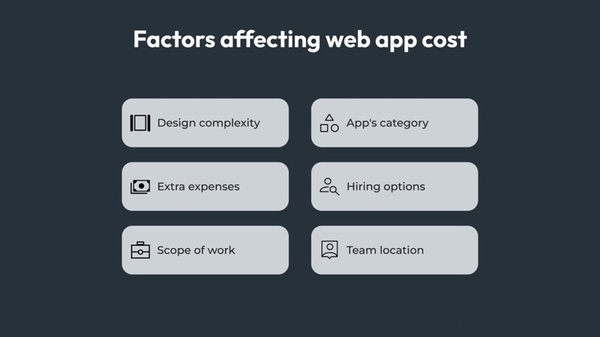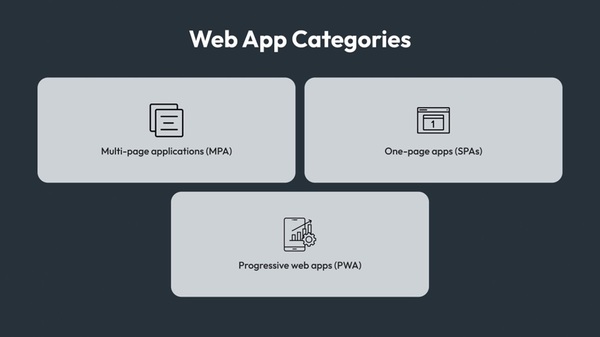The process of web application development is full of changes and challenges due to technological development, audience change, taste growth, and, surprisingly, it changes year by year. In 2024, it is important to be aware of multiple factors influencing the financial side of budgeting for web application development.
It is valuable to take into account project complexities, best approaches to development, typical spending points, the main motivators to invest in web application creation, and ways to keep the development inexpensive. Thus, our comprehensive guide could assist in developing a sustainable business strategy.
Exploring the Cost Factors of Web Application Development
In general, the development of a web application is a costly process driven by various influencers. Business owners should be aware of multiple points influencing the cost of development on different levels.

Project complexity and scope
Starting from simple applications that have no complicated features, and include a landing page, a contact form, or no more than several forms, such applications are the cheapest to develop. They usually cost between $5,000 and $15,000.
The medium complex level is characterized by advanced applications with such features as user authentication, interactive dashboards, integration with third-party services, and responsiveness on all devices. These applications often cost between $20,000 and $50,000.
The most costly is the complex level of application, which is usually feature-rich and has real-time data, an extensive database, ultra-security, custom animations, and many user rules. The development of these applications cost between $60,000 and $150,000.
UI/UX design
One of the most costly components in the given cost matrix is a well-developed User Interface/User Experience design. It’s because of the need to do a great deal of research, continuous testing, and prototyping. A well-designed UI/UX also has a direct influence on user engagement, usefulness, visual appeal, and overall satisfaction with the product or service. So you should invest in a strong UI/UX design if you want to achieve high levels of user engagement and customer satisfaction.
Technology stack
Web development is impossible without multiple programming technologies used to bring the app to life. React, Vue.js, Angular, and Node.js are some of the most used technologies, which are different and unique in terms of app development. The application of the latest technologies is advantageous but costly in terms of development as only professionals can work with them. When considering web apps’ major types, the choice of technology stack significantly impacts both functionality and cost.

Development team location
There is a significant difference in terms of web application development costs depending on region. Hiring a team in North America or Western Europe would be much more costly if compared to hiring in Central and Eastern Europe.
Team composition
Teams usually consist of project managers, front-end and back-end developers, designers, QA testers, and DevOps engineers. This team size is relational to the costs of development.
Maintenance and support
Another crucial factor that is frequently missed in the original budgeting process is post-launch support and maintenance. These continuing costs (e.g., app maintenance cost and support one) are necessary to guarantee the application’s seamless functioning and optimization going forward.
System integration
If a particular web application is an integration system, it could be also expensive to develop due to the complication of the task and a number of custom applications.
Security
Finally, security concerns are a vital part of web application development today. Such measures comply with regulations and direct development costs.
Exploring Effective Development Approaches
Every company aims to select a development approach that achieves a balance between saving costs, ensuring quality, and delivering projects on time. Their effectiveness in choosing depends on the specific nature of each methodology and its suitability for the project’s requirements. Every methodology is designed with its own internal rationale, distinct advantages, and limitations meant to serve various purposes or adapt to diverse organizational environments.
- Agile methodology
Agile methodologies ensure the iterative way to develop software by breaking it into manageable, smaller pieces. Flexibility is at the core of the Agile approach as the teams continuously adjust based on the feedback clients provide. The concerns of the Agile framework lie in guaranteeing necessary incremental value to be delivered in the future and ensuring that the final product is in tune with current requirements.
- The Waterfall model
The traditional software processes follow a linear trajectory where each phase should be completed before the next one begins. The approach is optimal for relatively simple projects with clear requirements developed initially. Moreover, the objectives that the waterfall model was designed to fulfill can be a serious limitation to project implementation. Namely, it is incredibly difficult to anticipate or predict changing requirements and objectives that will inevitably happen on long-term projects.
- DevOps and CI/CD
Combining DevOps practices and Continuous Integration/Continuous Deployment pipelines allows companies to streamline software delivery while automating the process of building, testing, and deployment. As delivery is automated with CI/CD practices, development and operational teams will work closer together, share most of the work, and gain additional expertise. Automated CI/CD pipelines significantly reduce the time from committing changes to the deployment of an update.
- Low-code/no-code platforms
The development of low-code or no-code platforms has been a drastic change that met the growing demand for rapid prototyping. The no-code platforms allow business users without any development background to create simple solutions to problems identified during their work. These tools automate a significant portion of work development, reducing costs and time-consuming efforts.
- Outsourcing vs In-house Development
Long-term in-house software development projects have proved to provide more in-depth control and ensure the pursuit of long-term company interests. On the contrary, short projects are more cost-effective when outsourced to agencies or freelancers.
Estimating expenses is a common practice when it comes to launching a new web application. Although the ultimate cost may vary according to a number of factors, the most significant are the number of development hours and the involvement of various professionals. In general, the expert team behind the development includes developers, UI/UX designers, project managers, business analysts, QA engineers, DevOps specialists, and team leads. According to their level of expertise and the extent of their involvement, the expense will range from $5,000 to more than $250,000 for more sophisticated applications.
Why Choose Web Application Development?
There are many reasons why investing in web application development can bring a wide range of benefits to businesses that can change their operations and connections to their audience. Let’s take a look at why building a web application is becoming so critical to organizations.
- Improved accessibility and convenience
Web applications have better accessibility that allows users to connect from any device with an internet connection. It means that users can access services and content at their convenience when they are at home, at their workplace, or on the go. Furthermore, they do not have to install any additional software to access services-specific means that web applications can make their experience conform to the user’s context.
- Better user experience
Web application development allows for a better user experience in many ways. First and foremost, a seamless web application can attract users and retain their attention. The users should be able to navigate smoothly, find what they are looking for, and complete all their tasks effectively. The more the users’ experience tailors to their needs, the more they are likely to continue using the services.
- Cost-effectiveness
Instead of building and managing a separate application for every platform, web applications save the cost of developing a separate codebase for different platforms and devices. Therefore, any company can enjoy the economy at a scale that can be maintained over time. Additionally, any web application can be managed with less operational overhead by a single team of IT professionals. This means that businesses can spend their expenses for the use of resources more effectively, making them more competitive in the market.
- Easy market expansion
Since web applications are not restricted to any geographical area, they can be used to expand the market presence of businesses. With different applications adapted to users of different backgrounds and abilities worldwide, any organization operating an app allows all users worldwide to use the same app.
Straightforward integration with business systems and other significant digital tools
Web applications can be easily integrated with the current systems and tools businesses use. It can be custom service tools for managing customer relationships, payment gateway tools, or analytics tools for meaningful work. This allows businesses to function better and make informed decisions.
Conclusion
Without a doubt, a number of distinct issues determine the cost of developing a web application in 2024. Selecting the most appropriate development approach and employing effective cost-minimization strategies are integral to this process. By carefully planning and following these steps, businesses can create high-quality online applications that will be both in line with their preferences and affordable. It is because of the companies’ ability to effectively manage costs and maintain this level of quality as well as adapt to the changing needs and desires of the audience that they will succeed.
Post Credits:
Yuliya Melnik is a technical writer at Cleveroad, an inventory management software development company in Ukraine. She is passionate about innovative technologies that make the world a better place and loves creating content that evokes vivid emotions.

